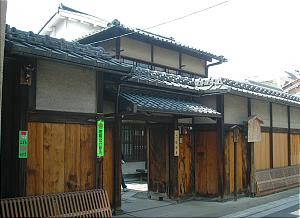

The house contains fire-resistant earthen walls and a warren of 24 rooms, and was ingeniously designed to protect the daimyo against possible surprise attacks.

The Imperial Palace is surrounded by a spacious park with a welcome landscape of trees and open lawn - it's Kyoto's very own Central Park. It's perfect for picnics, strolls and just about any sport that doesn't require retrieving balls over walls. Best of all, it's free. Take some time to visit the pond at the park's southern end, with its gaping carp. The park is most beautiful in the plum- and cherry-blossom seasons (early March and early April, respectively).

The Nanzen-ji Temple is one of Kyoto's most pleasant temples, with expansive grounds and numerous sub-temples. It began as a retirement villa for Emperor Kameyama but was dedicated as a Zen temple on his death in 1291. Civil war in the 15th century destroyed most of it; the present buildings date from the 17th century.
Kinkaku-ji
For a retirement home, the

gold-sheathed Kinkaku-ji is pretty magnificent. Shogun Yoshimitsu Ashikaga (1358-1409) had it constructed in 1393 for the time when he would quit politics -- the following year, in fact -- to manage the affairs of state through the new shogun, his 10-year-old son. On Yoshimitsu's death, his son followed his father's wishes and converted the villa into a temple named Rokuon-ji. The structure sits, following the Shinden style of the Heian period, at the edge of the lake. Pillars support the three-story pavilion, which extends over the pond and is reflected in the calm waters. To underscore this statement of his prestige and power, the shogun had the ceiling of the third floor of the pavilion covered in gold leaf.
In 1950 a student monk with metaphysical aspirations torched Kinkaku-ji, burning it to the ground. (Yukio Mishima's book Temple of the Golden Pavilion is a fictional exploration of the mind of the student.) Kinkaku-ji was rebuilt in 1955 based on the original design, except that all three stories were covered with gold leaf, in accordance with the shogun's original intention, instead of only the third-floor ceiling.
Kiyomizu -dera
Kiyomizu 1-chome, Higashiyama-ku, Kyoto

For centuries visitors and pilgrims have climbed the cobbled streets to Kiyomizu-dera, which stands prominently on a steep hillside with fine views of the city. Supported in part by 139 pillars, the temple juts out over the valley. Finding the courage to set out on a daring, new adventure is likened to "taking a leap from the veranda of Kiyomizu." The cypress-shingle roof harmonizes with the cryptomeria-covered hills, and below is the slender Sound of Feathers waterfall, believed to be the original source of kiyomizu,or pure water, which is drunk to prevent illness, using long-handled cups. The valley stroll garden is meant to suggest the southern paradise of the bodhisattva Kannon, the 11-faced goddess of mercy.
Built in 788, the original temple, which today belongs to the Hosso sect, predates Kyoto by six years. Although Kiyomizu-dera honors the popular Kannon, to whom women pray for an easy childbirth, it has become over time a sort of everyman's temple. You'll see evidence of this throughout the grounds, from the stacked rows of little Jizo Bosatsu statues (representing the god of travel and children) to the many koma-inu(mythical guard dogs), donated by grateful patrons, marking the pathways.
Ryoan-ji
13 Goryoshita-machi, Ryoan-ji, Ukyo-ku, Kyoto

The garden at Ryoan-ji, rather than the temple, attracts people from all over the world. Knowing that the temple belongs to the Rinzai sect of Zen Buddhism may help you appreciate the austere aesthetics of the garden. It's a karesansui, a dry garden: just 15 rocks arranged in three groupings of seven, five, and three in gravel. From the temple's veranda, the proper viewing place, only 14 rocks can be seen at one time. Move slightly and another rock appears and one of the original 14 disappears. In the Buddhist world the number 15 denotes completeness. You must have a total view of the garden to make it a meaningful experience -- and yet, in the conditions of this world, that's not possible.
Gion
.jpg)
This is the legendary haunt of geisha, or geiko, as they are called in the ancient capital. In the early evening, in the glow of teahouse lanterns, you can see them scurrying along the cobbled backstreets on their high geta, white-faced, on the way to their appointments. In their wake their maikofollow -- the young apprentice geisha identified by the longer sleeves of their kimonos.
The culture of the geisha and ochaya (teahouse) developed in the 16th and 17th century, partly due to the banning of women from the Kabuki stage, which remains unchanged. Female performers channeled their artistic talents, including singing, dancing, and playing musical instruments, into entertaining the male patrons of teahouses. The heart of the district is on Hanami-koji-dori. Heading north, the street intersects with Shinmonzen-dori, which is famous for its antiques shops and art galleries. Here you can find collectors' items -- at collectors' prices -- which make for interesting browsing, if not buying.
Here you can see Geisha's dance in Gion




No comments:
Post a Comment